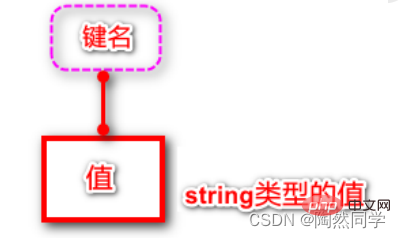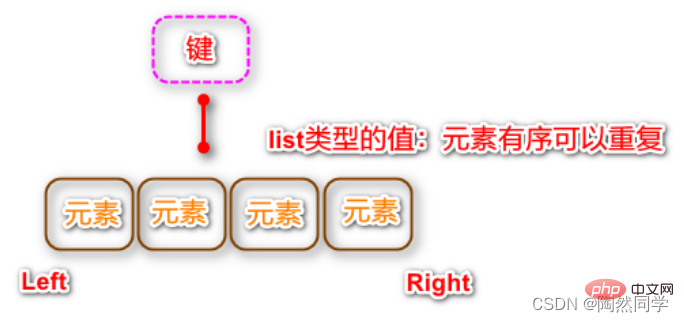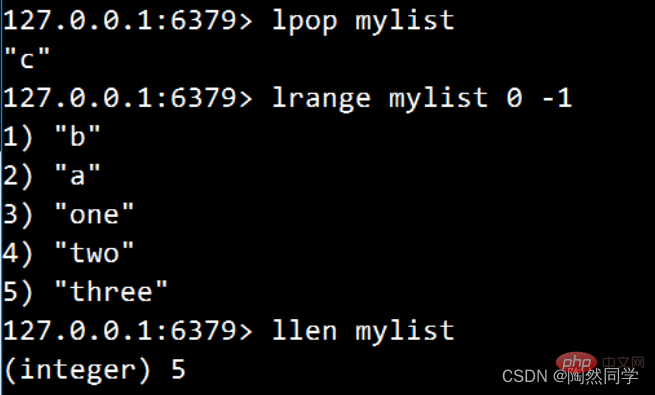Summary of Redis's five data types
This article brings you relevant knowledge about Redis, which mainly introduces related issues about data types, including string types, hash types, list types, collection types and Orderly collection, let’s take a look at it, I hope it will be helpful to everyone.

Recommended learning: Redis video tutorial
1. The 5 data types of Redis
redis is a An advanced key-value storage system, in which value supports five data types:
Key values supported by Redis Data type |
stringString Type |
hash table type |
list list type |
##set collection type |
zset ordered set type |
- Regarding the definition of key, please note the following points:
- It is not recommended that the key name is too long, usually no more than 1024, if it is too long it will Affects query speed.
- It is not recommended to be too short, as it will reduce readability.
- Generally in companies, there is a unified naming standard.

##Command |
Behavior |
||||||||||||||||||||||||||||||||||||||||||||||||||||||
set key value | Add 1 to the redis database Key and value of string type, return OK to indicate successful addition. The one with the same name will replace |||||||||||||||||||||||||||||||||||||||||||||||||||||||
get key | from the database Take out the value of a specified key, if there is a return value, if not return nil|||||||||||||||||||||||||||||||||||||||||||||||||||||||
del key | Delete the specified key and value. If the deletion is successful, return the number deleted. Otherwise return 0|||||||||||||||||||||||||||||||||||||||||||||||||||||||
| ##setnx key value When the specified key does not exist, set the specified value for the key. | If the setting is successful, 1 will be returned. Setup fails and returns 0.
Order |
Behavior |
||||||||||||||||||||||||||||||||||||||||
##hset key field value |
Add a pair of hash type field names and values to the specified key | ||||||||||||||||||||||||||||||||||||||||
hget key Field |
Get the value of the specified field of the specified key | ||||||||||||||||||||||||||||||||||||||||
hmset key Field valueField value | ##mulitple , set multiple field names and values to a key at one time |||||||||||||||||||||||||||||||||||||||||
| ##hmget ## Key Field fieldGet the values of multiple fields from the specified key at one time |
|||||||||||||||||||||||||||||||||||||||||
field field Delete one or more fields in a key |
|||||||||||||||||||||||||||||||||||||||||
Get all field values of a certain key |
# 3.3 Command DemonstrationRequirements: Create a hash type key as user, and add a field as username, with a value of newboy Add a field to user as password, the value is 12345 Add the field age to user, the value is 18 Get the field values of username, password and age in user respectively
Add multiple fields and values to user at the same time, birthday 2018-01-01 sex male
Get multiple fields at the same time: age and sex
Get all the fields and values in user
Delete the birthday and password fields in user
4. List type list4.1 OverviewIn Redis, the List type is a linked list of strings sorted in insertion order. Like an ordinary linked list in the data structure, we can add new elements to its left and right parts. During insertion, if the key does not exist, Redis will create a new linked list for the key. If the key already exists, it will add elements to the list. In contrast, if all elements in the linked list are removed, the key will also be deleted from the database. The maximum number of elements that can be contained in a List is 4 billion.
4.2 Common commands
|
The above is the detailed content of Summary of Redis's five data types. For more information, please follow other related articles on the PHP Chinese website!

Hot AI Tools

Undresser.AI Undress
AI-powered app for creating realistic nude photos

AI Clothes Remover
Online AI tool for removing clothes from photos.

Undress AI Tool
Undress images for free

Clothoff.io
AI clothes remover

Video Face Swap
Swap faces in any video effortlessly with our completely free AI face swap tool!

Hot Article

Hot Tools

Notepad++7.3.1
Easy-to-use and free code editor

SublimeText3 Chinese version
Chinese version, very easy to use

Zend Studio 13.0.1
Powerful PHP integrated development environment

Dreamweaver CS6
Visual web development tools

SublimeText3 Mac version
God-level code editing software (SublimeText3)

Hot Topics
 1386
1386
 52
52
 How to build the redis cluster mode
Apr 10, 2025 pm 10:15 PM
How to build the redis cluster mode
Apr 10, 2025 pm 10:15 PM
Redis cluster mode deploys Redis instances to multiple servers through sharding, improving scalability and availability. The construction steps are as follows: Create odd Redis instances with different ports; Create 3 sentinel instances, monitor Redis instances and failover; configure sentinel configuration files, add monitoring Redis instance information and failover settings; configure Redis instance configuration files, enable cluster mode and specify the cluster information file path; create nodes.conf file, containing information of each Redis instance; start the cluster, execute the create command to create a cluster and specify the number of replicas; log in to the cluster to execute the CLUSTER INFO command to verify the cluster status; make
 How to clear redis data
Apr 10, 2025 pm 10:06 PM
How to clear redis data
Apr 10, 2025 pm 10:06 PM
How to clear Redis data: Use the FLUSHALL command to clear all key values. Use the FLUSHDB command to clear the key value of the currently selected database. Use SELECT to switch databases, and then use FLUSHDB to clear multiple databases. Use the DEL command to delete a specific key. Use the redis-cli tool to clear the data.
 How to read redis queue
Apr 10, 2025 pm 10:12 PM
How to read redis queue
Apr 10, 2025 pm 10:12 PM
To read a queue from Redis, you need to get the queue name, read the elements using the LPOP command, and process the empty queue. The specific steps are as follows: Get the queue name: name it with the prefix of "queue:" such as "queue:my-queue". Use the LPOP command: Eject the element from the head of the queue and return its value, such as LPOP queue:my-queue. Processing empty queues: If the queue is empty, LPOP returns nil, and you can check whether the queue exists before reading the element.
 How to use the redis command
Apr 10, 2025 pm 08:45 PM
How to use the redis command
Apr 10, 2025 pm 08:45 PM
Using the Redis directive requires the following steps: Open the Redis client. Enter the command (verb key value). Provides the required parameters (varies from instruction to instruction). Press Enter to execute the command. Redis returns a response indicating the result of the operation (usually OK or -ERR).
 How to use redis lock
Apr 10, 2025 pm 08:39 PM
How to use redis lock
Apr 10, 2025 pm 08:39 PM
Using Redis to lock operations requires obtaining the lock through the SETNX command, and then using the EXPIRE command to set the expiration time. The specific steps are: (1) Use the SETNX command to try to set a key-value pair; (2) Use the EXPIRE command to set the expiration time for the lock; (3) Use the DEL command to delete the lock when the lock is no longer needed.
 How to read the source code of redis
Apr 10, 2025 pm 08:27 PM
How to read the source code of redis
Apr 10, 2025 pm 08:27 PM
The best way to understand Redis source code is to go step by step: get familiar with the basics of Redis. Select a specific module or function as the starting point. Start with the entry point of the module or function and view the code line by line. View the code through the function call chain. Be familiar with the underlying data structures used by Redis. Identify the algorithm used by Redis.
 How to make message middleware for redis
Apr 10, 2025 pm 07:51 PM
How to make message middleware for redis
Apr 10, 2025 pm 07:51 PM
Redis, as a message middleware, supports production-consumption models, can persist messages and ensure reliable delivery. Using Redis as the message middleware enables low latency, reliable and scalable messaging.
 How to start the server with redis
Apr 10, 2025 pm 08:12 PM
How to start the server with redis
Apr 10, 2025 pm 08:12 PM
The steps to start a Redis server include: Install Redis according to the operating system. Start the Redis service via redis-server (Linux/macOS) or redis-server.exe (Windows). Use the redis-cli ping (Linux/macOS) or redis-cli.exe ping (Windows) command to check the service status. Use a Redis client, such as redis-cli, Python, or Node.js, to access the server.





















